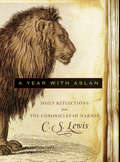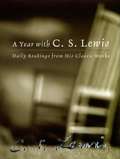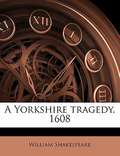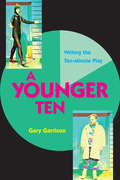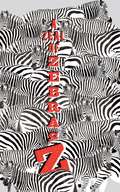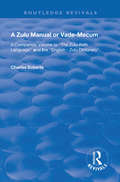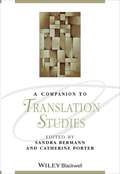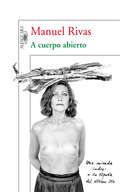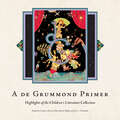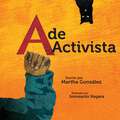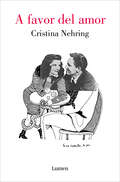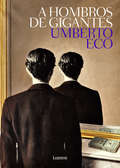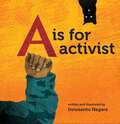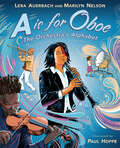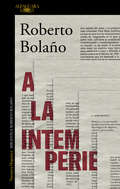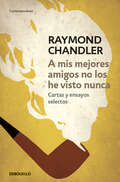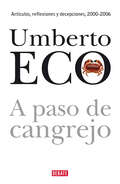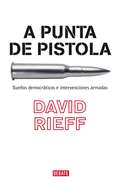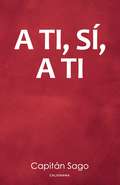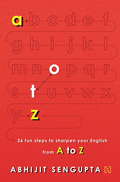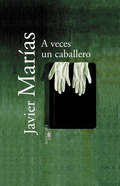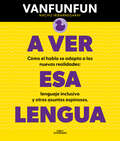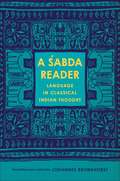- Table View
- List View
A Year with Aslan
by C. S. LewisFor more than fifty years, the world C. S. Lewis created in Narnia has captured our hearts and imaginations. Both children and adults have discovered that rereading the books leads to entirely new experiences and insights. In the midst of these breathtaking stories of adventure, betrayal, and discovery in a magical land are profound messages about the true meaning of life. Whether it is Eustace struggling with his dragon skin, Digory debating obedience to Aslan versus saving his mother, or Edmund facing his shame after his rescue from the White Witch, the questions and dilemmas facing the characters are surprisingly relevant to us today. By pondering the world of Narnia, we better understand our own.In the first book of its kind, A Year with Aslan offers 365 of the most thought-provoking passages from all seven books, paired with reflective questions that get at the heart of what matters most. An unprecedented way to experience the magic of Narnia every day of the year, A Year with Aslan allows us all to go "Further up and further in!"
A Year with C. S. Lewis: Daily Readings From His Classic Works
by C. S. LewisBeloved author C. S. Lewis is our trusted guide in this intimate day-by-day companion offering his distinctive and celebrated wisdom. Amidst the bustle of our daily experience, A Year with C. S. Lewis provides the necessary respite and inspiration to meet the many challenges we face in our lives. Ruminating on such themes as the nature of love, the existence of miracles, overcoming a devastating loss, and discovering a profound faith, Lewis offers unflinchingly honest insight for each day of the year. These daily meditations have been culled from Lewis's celebrated Signature Classics: Mere Christianity, The Screwtape Letters, The Great Divorce, The Problem of Pain, Miracles, and A Grief Observed, as well as from the distinguished works The Weight of Glory and The Abolition of Man. Throughout this elegant daybook the reader will find poignant biographical com-mentary about C. S. Lewis's life that offers a remarkable portrait of Lewis in the context of his work. As each day unfolds, we embark on a path of discovery with a friend by your side. A Year with C. S. Lewis is the perfect com-panion for everyone who cherishes Lewis's timeless words.
A Yorkshire Tragedy
by ShakespeareThe plot of the play is based on the biographical account of Walter Calverley of Calverley Hall, Yorkshire, who was executed on 5 August 1605 for murdering two of his children and stabbing his wife. <P> <P> The crimes were a well-known scandal of the day; a pamphlet on the case was issued in June 1605, with a ballad following in July. The chronicler John Stow reported the case in his Annals.[1][2] The murders were also dramatised in a play titled The Miseries of Enforced Marriage (1607), by George Wilkins. Scholars have disagreed on the relationship between Wilkins's play and A Yorkshire Tragedy; some of have seen one play as a source for the other, or even the work of the same author, while others regard the two dramas as essentially separate works.[3]
A Younger Ten: Writing the Ten-Minute Play
by Gary GarrisonIn A Younger Ten: Writing the Ten-Minute Play, Gary Garrison distills the playwriting guidance pioneered in his widely consulted Perfect Ten (2001) and A More Perfect Ten (2008), here recast for the needs of aspiring ten-minute playwrights at the high school level. Not satisfied with merely telling how such a play is crafted, Garrison includes a new all-star lineup of eight complete ten-minute plays by a variety of playwrights, emerging as well as established, that can serve as models for writers just starting out in the genre.
A Zeal of Zebras
by Woop StudiosAn embarrassment of pandas, a galaxy of starfish, a shiver of sharks...these are all collective nouns used to describe their groups. Woop Studios, acclaimed for their work on the Harry Potter movies, has illustrated these quirky phrases, creating a series of extraordinarily beautiful art that has been collected here for the first time. The colorful introduction to animals and the alphabet is accessible for young children, while the gorgeous, whimsical art and clever wordplay make it perfect for design-savvy parents and inspired gift givers. Longer than the standard picture book, with high design and production values, this is a volume readers will want on their coffee tables in addition to their child's bookshelf.
A Zulu Manual or Vade-Mecum: A Companion Volume to ''The Zulu-Kafir Language'', And The '' English - Zulu Dictonary''. (Routledge Revivals)
by Charles RobertsPublished in 1900, this book provides a companion volume to the Zulu Kafir Language and the English Zulu Dictionary. Including a dictionary and examples of language structure and grammar, this book makes Zulu accessible to all levels of learner.
A companion to translation studies
by Catherine Porter Edited By Sandra BermannThis series offers comprehensive, newly written surveys of key periods and movements and certain major authors, in English literary culture and history. Extensive volumes provide new perspectives and positions on contexts and on canonical and post-canonical texts, orientating the beginning student in new fields of study and providing the experienced undergraduate
A cuerpo abierto
by Manuel RivasUn libro de artículos fundamentalmente crítico y a medio camino entre el periodismo y la literatura. «Este es un viaje de periodismo indie. Independiente, libre, irónico, crítico y de fábrica literaria. Digo eso, lo de literario, sin complejo. El mejor periodismo constituye siempre una pieza literaria. El sentido de A cuerpo abierto, en todo caso, responde a un propósito que con encarnizada precisión enunció Rodolfo Walsh. Esa idea de que escribir es un avance laborioso contra la estupidez.»Manuel Rivas
A de Grummond Primer: Highlights of the Children's Literature Collection
by Carolyn J. Brown, Ellen Hunter Ruffin, and Eric L. TribunellaContributions by Ann Mulloy Ashmore, Rudine Sims Bishop, Ruth B. Bottigheimer, Jennifer Brannock, Carolyn J. Brown, Ramona Caponegro, Lorinda Cohoon, Carol Edmonston, Paige Gray, Laura Hakala, Andrew Haley, Wm John Hare, Dee Jones, Allison G. Kaplan, Megan Norcia, Nathalie op de Beeck, Amy Pattee, Deborah Pope, Ellen Hunter Ruffin, Anita Silvey, Danielle Bishop Stoulig, Roger Sutton, Deborah D. Taylor, Eric L. Tribunella, Alexandra Valint, and Laura E. Wasowicz During the 1960s, a dedicated library science professor named Lena de Grummond initiated a letter-writing campaign to children’s authors and illustrators requesting original manuscripts and artwork to share with her students. Now named after de Grummond, this archive at the University of Southern Mississippi has grown into one of the largest collections of historical and contemporary youth literature in North America with original contributions from more than 1,400 authors and illustrators, as well as over 185,000 volumes. The first book-length project on the collection, A de Grummond Primer: Highlights of the Children's Literature Collection provides a history of de Grummond’s work and an introduction to major topics in the field of children’s literature. With more than ninety full-color images, it highlights particular strengths of the archive, including extensive holdings of fairy tales, series books, nineteenth-century periodicals, Golden Age illustrated books, Mississippi and southern children’s literature, nonfiction, African American children’s literature, contemporary children’s and young adult authors and illustrators, and more. The book includes contributions from literature and information science scholars, historians, librarians, and archivists—all noted experts on children’s literature—and points to the exciting research possibilities of the archive.De Grummond could not have realized when she wrote to luminaries like H. A. and Margret Rey, Berta and Elmer Hader, Madeleine L’Engle, J. R. R. Tolkien, Lois Lenski, Garth Williams, and others that their correspondence and contributions would form the foundation for this extraordinary trove now visited by scholars from around the world. Such major authors and illustrators as Ezra Jack Keats, Richard Peck, Rosemary Wells, Angela Johnson, and John Green continued to donate content. In addition, curators, past and present, have acquired both historical and contemporary volumes of literature and criticism.
A de activista
by Martha E. Gonzalez Innosanto NagaraFollowing on the outrageous success of Innosanto Nagara's A is for Activist (now in its fourth printing), A de Activista is a Spanish-language ABC board book written by Grammy Award-winning lyricist and singer Martha Gonzalez and illustrated by Nagara for the next generation of progressives: families who want their kids to grow up in a space that is unapologetic about activism, environmental justice, civil rights, LGBTQ rights, and everything else that activists believe in and fight for. The alliteration, rhyming, and vibrant illustrations make the book exciting for children, calling them to action while teaching them a love for books.From the Board edition.
A favor del amor
by Cristina NehringUna reivindicación del amor pasional como fuerza creadora. «Fresca e inteligente. Nehring lleva al lector por un viaje fascinante que bebe de la mejor literatura.»Mario Vargas Llosa Desde siempre, el hecho de vivir de una manera intensa una pasión amorosa se ha considerado como una mancha negra a la hora de valorar la capacidad intelectual de una mujer, un hecho que en cambio no se da en el caso de los hombres. Muchos criticaron, por ejemplo, a Mary Wollstonecraft –la autora de los Derechos de la mujer- por haber sucumbido al amor por un hombre hasta el punto de intentar dos veces el suicidio; en cambio, Petrarca pudo dedicar toda su vida a suspirar por Laura, sin que eso mermara su prestigio de poeta. Las hazañas eróticas de los hombres son un plus en la consideración de su prójimo; las aventuras de las mujeres son deslices que pueden distraerlas de sus tareas de profesionales... Lo curioso es que ese prejuicio no está instalado solo en la mente del varón, sino que ha sido cultivado por el movimiento feminista, que veía la relación heterosexual como una experiencia cercana a la violación y consideraba toda relación romántica entre hombre y mujer como un signo de debilidad. Hoy, en pleno siglo XXI, el miedo a la enfermedad y el gusto por la eficacia han reducido el arrebato amoroso a un juego controlado y a menudo aburrido, que puede durar una noche o alargarse hacia una vida de pareja dictada por la sensatez y el cálculo. ¿Dónde ha quedado entonces la locura amorosa? Al hilo de las teorías y experiencias que nos ha dejado la tradición de Occidente –desde Dante y Shakespeare a Emily Dickinson y Simone Beauvoir-, alternando conceptos abstractos y apuntes de vida real, Nehring propone un nuevo acercamiento a la pasión, entendida como una lucha vital que nos hace crecer como individuos. Seamos hombres o mujeres, esa locura amorosa que, contrariamente a lo que suele decirse, nos vuelve clarividentes con respecto al otro, es finalmente una de las nuevas y hermosas reivindicaciones de nuestro siglo. La crítica ha dicho:«Una auténtica bofetada en la cara. Tanto para las feministas de la vieja guardia como para la sociedad patriarcal en la que continuamos viviendo. [...] Un ensayo francamente recomendable para comprender la carga que durante décadas, y probablemente todavía hoy, llevan quienes, además de ser mujeres, escriben sobre el amor.»Álvaro Colomer, El Mundo «Un ensayo sugerente y polémico [que] apuesta por las relaciones maduras entre iguales en un nuevo entendimiento de la pasión erótica.»Manuel Rodríguez Rivero, Babelia «Un libro feroz, divertido [...] y único que te hace reflexionar sobre tu vida íntima de una manera nueva.»New York Times Book Review «Una defensa entusiasta del ardor imprudente y el exceso romántico. [...] Nadie se atreverá a negar que Nehring tiene razón.»Wall Street Journal
A hombros de gigantes
by Umberto EcoEco inédito. Las brillantes clases magistrales que Umberto Eco pronunciaba en la universidad, junto con una que no llegó a pronunciar. «Somos como enanos que están a hombros de gigantes, de modo que podemos ver más lejos que ellos, no tanto por nuestra estatura o nuestra agudeza visual, sino porque, al estar sobre sus hombros, estamos más altos que ellos.»Bernardo de Chartres A hombros de gigantes representa para los lectores de Eco un evento festivo. Lejos de las aulas universitarias, de las conferencias académicas y de las ceremonias de honor Eco escribe estos textos a lo largo de tres lustros, para entretener a los numerosísimos espectadores de la Milanesiana, el festival creado y dirigido por Elisabetta Sgarbi. Son textos que se inspiran a menudo en el tema central elegido cada año en la Milanesiana, pero que luego recorren ríos de repertorios que beben de la filosofía, la literatura, la estética, la ética y los medios de comunicación para devolvernos, en un lenguaje afable, imbuido de ironía, a veces lúdico o mordaz, la quintaesencia del universo de Eco. La crítica ha dicho...«Diez siglos en una frase, ese es el método Eco. A hombros de gigantes es una de las más brillantes y majestuosas colecciones de apuntes que un curso universitario podría ofrecer.»Paolo di Paolo, La Repubblica «En tiempos de crisis radical del progreso, de dudas sobre la existencia misma de un mañana (el futuro es una imaginación) y de la obsesión identitaria que coloca las utopías en el pasado, A hombros de gigantes es una bocanada de aire fresco.»Wlodek Goldkorn, L'Espresso «Una narración que tiene la calidad de las clases de Eco, que sus alumnos tanto añoran [...]. Este libro es una muestra ejemplar de quién era Eco.»Furio Colombo, Il Fatto Quotidiano «La lección póstuma de Umberto Eco: para ver desde arriba el juicio universal es mejor subirse a hombros de los antepasados.»Gianfranco Marrone, La Stampa «Este gigantesco sabio a quien nada humano le era ajeno demuestra que lo lúdico no está reñido con lo académico, [...] un pretexto para navegar por los meandros de su vasta sabiduría mezclando filosofía, literatura, estética, ética o el análisis de los "mass media".»Miguel Lorenci, El Comercio
A is for Activist
by Innosanto NagaraOne of NPR's Top 100 Book for Young Readers &“Reading it is almost like reading Howard Zinn's A People's History of the United States, but for two-year olds—full of pictures and rhymes and a little cat to find on every page that will delight the curious toddler and parents alike.&”—Occupy Wall StreetA is for Activist is an ABC board book written and illustrated for the next generation of progressives: families who want their kids to grow up in a space that is unapologetic about activism, environmental justice, civil rights, LGBTQ rights, and everything else that activists believe in and fight for. The alliteration, rhyming, and vibrant illustrations make the book exciting for children, while the issues it brings up resonate with their parents' values of community, equality, and justice. This engaging little book carries huge messages as it inspires hope for the future, and calls children to action while teaching them a love for books.
A is for Oboe: The Orchestra's Alphabet
by Marilyn Nelson Lera AuerbachThis deeply imaginative and entertaining poetry collection details the pleasures of the orchestra, from strong-willed A to satisfied Z.Two widely acclaimed poets--one a composer and classical pianist as well--have come together to create this extraordinary portrait of the orchestra in all of its richness and fascination, using the structure of the alphabet in a way that's entirely new and delightful. A is for the first note you hear as you take your seat in the concert hall, played by the headstrong oboe. B is for the bassoon, "the orchestra's jester, complaining impatiently through his nose." And C is for the conductor, "like the captain on the bridge of a great ship, navigating the composer's musical charts." Onward the text goes, soaring in reverie and making thought-provoking observations while not taking itself too seriously--illuminating all the various details that flow together to create the nourishing experience of playing or listening to music.
A la intemperie: Colaboraciones periodísticas, intervenciones públicas y ensayos
by Roberto BolañoTodos los textos de no ficción escritos por Roberto Bolaño: pequeñas piezas maestras de uno de los escritores más originales de la literatura contemporánea en español. \ <P><P>«Déjenlo todo, nuevamente. Láncense a los caminos.» (Del manifiesto infrarrealista) A la intemperie compila todas las columnas, los artículos y las reseñas publicadas por Roberto Bolaño en medios españoles e hispanoamericanos desde la década de los setenta y hasta su muerte en 2003. <P><P>Asimismo, se recogen en el libro los prólogos escritos para obras de otros autores, las conferencias y los discursos pronunciados, y el sugerente manifiesto infrarrealista formulado en la etapa creativa de México. El humor, la literatura y la cultura, las reflexiones que atraviesan sus obras narrativas, sus lecturas, su visión del mundo -en ocasiones polémica, siempre desinhibida- y numerosas anécdotas conviven en este volumen que da a conocer otra faceta del autor: más teórica, sí, pero tan profundamente autobiográfica como la que atraviesa sus obras más conocidas. Una muestra del genio creador que convirtió a Bolaño en uno de los escritores contemporáneos más importantes. <P><P>«A la intemperie nos permite esa mezcla de curiosidad y espionaje que los millenials llaman estalqueo: la ocasión de escudriñar cuanto Bolaño pensaba -o acaso no pensaba, pero sí escribía- sobre sus caballitos de batalla, sus próceres y enemigos literarios, con una mirada hacia su extravagante mundo interior.» <P><P>Del prólogo de Jorge Volpi
A mis mejores amigos no los he visto nunca: Cartas y ensayos selectos
by Raymond ChandlerUn viaje excepcional al mundo de Chandler, marcado por la genialidad, el alcoholismo, la soledad y la visión crítica de la industria del cine. Una lectura fundamental para los fans del género. A mis mejores amigos no los he visto nunca recoge una amplísima selección de la correspondencia y la obra periodística de Raymond Chandler, y constituye como tal un volumen inédito. Aquí se desvelan sus reflexiones literarias, que se caracterizan por un gran sentido del humor, los secretos de su personalidad siempre al borde del abismo, su intuición artística, su curiosidad intelectual y su tormentosa relación con Hollywood. La primera parte del libro es una antología de sus cartas a amigos, editores, agentes y colegas que se lee como una fascinante biografía. La segunda parte consiste en una decena de artículos escritos para la prensa -varios nunca antes traducidos- , que retratan su cambiante visión del mundo a lo largo de los años. Reseña:La obra de Chandler me parece tan imprescindible literariamente como pueda serlo la de Hemingway o Scott Fitzgerald.»Manuel Vázquez Montalbán
A paso de cangrejo: Artículos, reflexiones y decepciones 2000-2006
by Umberto EcoAntología de los artículos publicados por Umberto Eco entre comienzos de 2000 y finales de 2005. A paso de cangrejo es como parece caminar la historia en este nuevo milenio. Tras el 11 de septiembre la humanidad entró en una peligrosa regresión. Volvieron los viejos conflictos territoriales, las guerras medievales con denominación de «cruzada», la nostalgia por los totalitarismos, el antisemitismo y otras formas de racismo. Eco arremete contra la forma de vida contemporánea, las guerras, la política internacional y el consumo en las grandes superficies como único espacio de ocio posible, sin olvidar el nefasto papel de los medios de comunicación, empeñados en construir una imagen del mundo basada en el espectáculo. El resultado es un libro intenso y combativo, cargado de lúcidos análisis sobre el escenario que nos rodea. La crítica opina...«Un trabajo excelente que escapa del maniqueísmo al uso y apuesta por la cautela intelectual ante un presente incierto como el nuestro.»ABC de las artes y las letras
A punta de pistola: Sueños democráticos e intervenciones armadas
by David Rieff¿Cuándo se debe intervenir militarmente en los asuntos internos de otros países? En este inquietante ensayo, David Rieff plantea una serie de cuestiones fundamentales que no podemos ignorar en esta era global. ¿Cuándo se debe intervenir militarmente en los asuntos internos de otros países? ¿Constituyen los derechos humanos y las cuestiones humanitarias razones legítimas para intervenir o es este asalto a la soberanía nacional una excusa para la recolonización de parte del mundo? ¿Qué papel deberían desempeñar las Naciones Unidas en la solución de las crisis humanitarias? Y sobre todo, ¿se puede imponer la democracia a punta de pistola? Los ensayos aquí reunidos presentan un penetrante retrato de lo que ocurre cuando los grandiosos planes de los políticos y las bienintencionadas ambiciones éticas de los activistas pro derechos humanos descarrilan terriblemente sobre el terreno. La pregunta que surge una y otra vez es ¿se corresponde esta ambición nuestra de proteger a la gente de las masacres y la penuria con nuestros medios y nuestra inteligencia? La respuesta no es optimista. Al contrario, es la desilusionada conclusión de un escritor que una vez abanderó la necesidad de tales intervenciones.
A ti, sí, a ti
by Capitán SagoSi te gusta la prosa poética y la investigación literaria... Este libro está escrito para escritores aficionados. En él se pueden encontrar los recursos necesarios para lograr decidirte a la poesía, para escribir tu propio libro...
A to Z: 26 Fun Steps to Sharpen your English
by Abhijit SenguptaWhy do we need good ? or better ? English Just 26 letters ? five vowels and 21 consonants ? have created perhaps the largest lexicon in the world and made English globally the most widely used language today for interaction in international trade, world sports and global politics, not to forget education. A to Z explores, letter by letter, how the English language, when used well, can be a powerful tool for writing, communication and creative expression for studies, business, entertainment and enjoyment. With the use of many examples and some amusing anecdotes, it also shows how, when used incorrectly, it can make one thing mean something entirely different! The book informs and reminds readers of the basics of grammar and punctuation, while offering tips on vocabulary for impressive communication. Simultaneously authoritative and friendly, this is the perfect book for students, lovers of language and everyone who wants to explore the nuances of the English language, and succeed at clear, correct and smart communication.
A veces un caballero
by Javier MaríasSin alharacas ni presunciones, Javier Marías se ha convertido en uno de los indiscutibles maestros del actual columnismo, como puede comprobarse en los ciento cuatro artículos contenidos en A veces un caballero, escritos entre 1998 y 2001. Casi siempre educado, resulta sin embargo más impertinente que cualquier provocador profesional, sin más adorno que el de la diversión, su prosa es siempre punzante y ágil; dotado para la vehemencia contagiosa, también es capaz de hacer soltar a menudo la carcajada; sin rehuir los asuntos cotidianos, nos lleva a pensar en nuestro tiempo de manera inesperada y profunda; sus rememoraciones ocasionales nunca caen en la excesiva nostalgia, pero logran emocionar sobriamente. Todo ello, cada vez, en el espacio de tres o cuatro páginas tan sólo. El autor consigue crear un estado de ánimo con cada pieza, y, lo que es más importante, hace que sus relatos y sus reflexiones lleguen a afectarnos personalmente, y que tras su lectura veamos un poco más claro y limpio el mundo por el que transitamos. «A veces un caballero... y a veces un rufián», como el propio Javier Marías reconoce en su prólogo, sus impecables razonamientos, sus evocaciones, su inconformidad y su guasa obran como infalible estímulo para la inteligencia.
A ver esa lengua: Cómo el habla se adapta a las nuevas realidades: lenguaje inclusivo y otros asuntos espinosos
by VanfunfunUsando palabras sencillas y argumentos de perroflauta punki de la lengua, defendidos por la lingüística más actual, este influencer de YouTube va a cambiar tu percepción de cómo se habla. ¡Hola! ¿Sabías que hablar mal es imposible? ¿Que la RAE no tiene la razón en muchas ocasiones? ¿Que el lenguaje inclusivo es bueno? ¿Que çe pue eccribî en andalû y no se acaba el mundo? ¿Y que, de hecho, la gente joven no está arruinando la lengua?
A Śabda Reader: Language in Classical Indian Thought (Historical Sourcebooks in Classical Indian Thought)
by Johannes BronkhorstLanguage (śabda) occupied a central yet often unacknowledged place in classical Indian philosophical thought. Foundational thinkers considered topics such as the nature of language, its relationship to reality, the nature and existence of linguistic units and their capacity to convey meaning, and the role of language in the interpretation of sacred writings. The first reader on language in—and the language of—classical Indian philosophy, A Śabda Reader offers a comprehensive and pedagogically valuable treatment of this topic and its importance to Indian philosophical thought.A Śabda Reader brings together newly translated passages by authors from a variety of traditions—Brahmin, Buddhist, Jaina—representing a number of schools of thought. It illuminates issues such as how Brahmanical thinkers understood the Veda and conceived of Sanskrit; how Buddhist thinkers came to assign importance to language’s link to phenomenal reality; how Jains saw language as strictly material; the possibility of self-contradictory sentences; and how words affect thought. Throughout, the volume shows that linguistic presuppositions and implicit notions about language often play as significant a role as explicit ideas and formal theories. Including an introduction that places the texts and ideas in their historical and cultural context, A Śabda Reader sheds light on a crucial aspect of classical Indian thought and in so doing deepens our understanding of the philosophy of language.
A, B, See!
by Tana HobanA collection of photograms of objects which begin with a particular letter of the alphabet.
